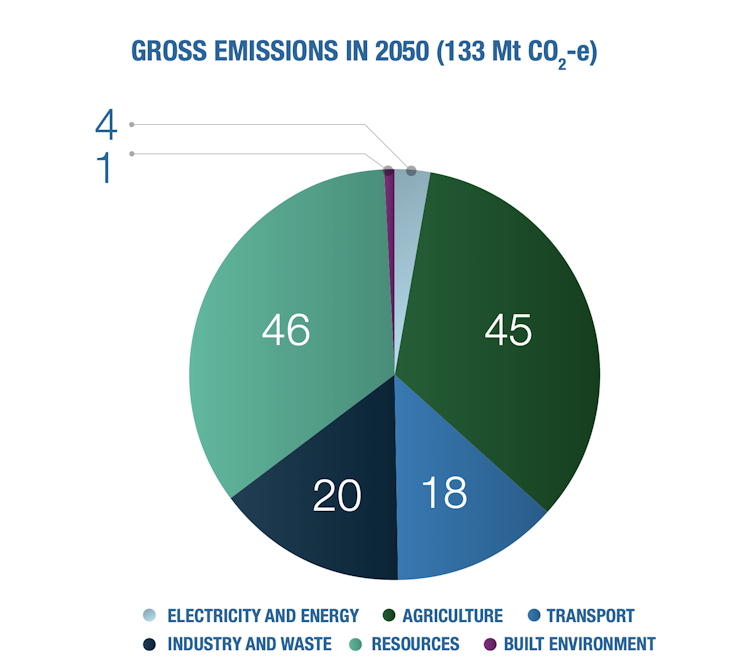Global carbon emissions from fossil fuels continue to rise and 2024 is likely to be the world’s hottest year on record.
It’s becoming increasingly clear that limiting global warming to 1.5°C will require much more than existing efforts to reduce emissions and decarbonise industry. We also need to remove enormous amounts of carbon dioxide from the atmosphere, 7-9 billion tonnes a year.
The Intergovernmental Panel on Climate Change (IPCC) says carbon dioxide removal technology will be required to achieve global and national net zero targets. In other words, there is no net zero without CO2-removal, because emissions of greenhouse gases are not declining anywhere near fast enough.
There will be trade-offs, as CO2-removal can be costly and often uses up energy, water and land. But Earth is hurtling towards a climate catastrophe, with more than 3°C of warming under current global policies. We must do everything we can to avert disaster, which means slashing emissions as much as we possibly can, and removing what’s left.
Within the international scientific community the debate about carbon dioxide removal has moved on from “could we, should we?” to “we must” — recognising the urgency of the situation. So it’s worth coming up to speed on the basics of carbon dioxide removal technology, both old and new, and the role we can expect it to play in Australia’s net-zero future.
Permanent carbon dioxide removal: for net zero and beyond (CSIRO).
Why do we need carbon dioxide removal?
Carbon dioxide removal accelerates natural processes such as storing carbon in trees, rocks, soil and the ocean. It differs from carbon capture and storage, which seeks to remove carbon before it enters the atmosphere.
As Australia’s Climate Change Authority states, reaching the national goal of net-zero emissions by 2050 does not mean all emissions are eliminated across the economy. Some emissions are likely to remain — about 25 per cent of Australia’s 2005 emissions under the current plan — and they need to be dealt with.
So how much carbon dioxide are we talking about? Some 133 million tonnes a year by mid-century, according to the authority. This equates to billions of tonnes of additional carbon dioxide removal over the next 25 years.
Ways to remove and store carbon dioxide from the atmosphere are among the federal government’s national science and research priorities. So let’s take a look at the technologies we are using now and what we might need.

What technologies do we need?
The international scientific community divides carbon dioxide removal technologies into “conventional” (nature-based) and “novel” (new) approaches.
The conventional technologies rely on biological processes, such as planting trees, boosting soil carbon levels and increasing carbon stores in coastal ecosystems such as mangroves. The carbon is typically stored over shorter timescales, from a decade to a century.
Unfortunately, many of these natural carbon stores or “sinks” are already becoming saturated. They will also become increasingly vulnerable in a changing climate. For example, forest fires are releasing billions of tonnes of carbon dioxide back into the atmosphere annually.

To reach net zero emissions, the world will need to find more durable ways to remove CO2 at scale from the atmosphere. This is where the new technologies come in.
Examples include adding crushed carbonate or silicate rock to the ocean or farmland. Research suggests waste rock from mining could be used for this purpose.
Concerningly, novel approaches currently comprise less than 0.1 per cent of total global carbon dioxide removal.
Avoiding potential pitfalls
Like all technologies, carbon dioxide removal comes with potential risks and tradeoffs.
In a market worth as much as US$1.1 trillion dollars (A$1.7 trillion) by 2050, there’s always a risk of overstating the benefits.
To counter this, the IPCC is developing evidence-based methods to ensure the amounts of carbon removed can be verified and included in national accounts. This should promote transparency and reduce the risk of greenwashing or making misleading claims.
Carbon dioxide removal can also affect the environment. For instance, some approaches such as tree planting may compete with agriculture or biodiversity conservation for water and land. This challenge is compounded by climate change.
Other approaches, such as direct air capture and storage, currently face technical challenges in extracting CO2 from air without consuming high amounts of energy.
The interests and rights of Australia’s First Nations communities must also be considered. A global survey of Indigenous people in 30 countries around the world, including Australia, found positive attitudes to climate intervention technologies. However, this is only a starting point. Greater engagement is needed nationally concerning specific carbon dioxide removal approaches.
More work is needed to understand these challenges, including how to manage them and their impacts on Australian communities.

A new industry for Australia?
Australia’s large land mass and vast oceans mean we have far greater physical capacity than other nations to store carbon.
Australia also has access to renewable energy used to power the technologies, and a skilled workforce to develop and run them.
Much like solar and wind energy, tackling carbon dioxide removal in Australia at the scale required will require a new industry with its own infrastructure, institutions and processes.
CSIRO and other organisations are advancing the technology, but more is needed. Australia requires a national dialogue and clear vision around how to deliver carbon dioxide removal responsibly and sustainably.
Of course, prevention is better than cure. It’s always better to cut emissions and stop carbon dioxide entering the atmosphere in the first place, than trying to remove it afterwards. But time is running out, carbon dioxide levels are already too high and we need to reach net zero by 2050.
Carbon dioxide removal is now essential, along with deep and urgent emissions reduction. We must get moving on permanent carbon dioxide removal if we are to preserve the planet for future generations.
Andrew Lenton, Director CarbonLock, Environment, CSIRO and Kerryn Brent, Research scientist, CSIRO
This article is republished from The Conversation under a Creative Commons license. Read the original article published Dec. 5, 2024.












